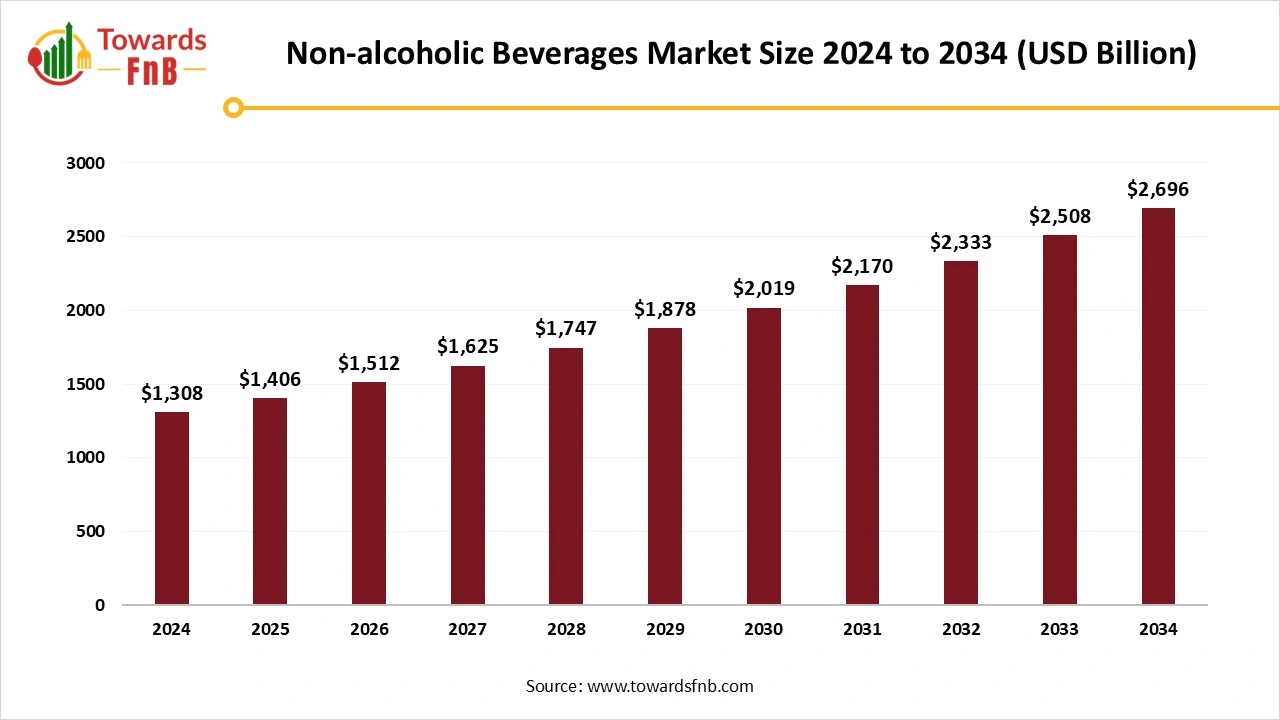April 2025
The non-alcoholic beverages market size is expected to increase from USD 1,406 billion in 2025 to USD 2,696 billion by 2034, growing at a CAGR of 7.50% during the forecast period from 2025 to 2034. The shift of consumers towards healthier lifestyle, change in consumer preferences and innovation in products variety holds the significant share for growth of the market.

Non-alcoholic beverages are potable liquid which has either no ethyl alcohol or less than 0.5% of alcohol in it. These may include premium coffee, cold drinks, carbonated drinks, bottled water, juices, functional drinks which are enriched with vitamins and other nutrients.
With the growing acceptance of the of the non-alcoholic beverages globally the market has seen the rise and growth rapidly. The change in lifestyle and change in preferences of the consumers have led this market, the shift towards healthier options like low calorie, low sugar content drinks has helped this market to grow and strict regulations by food and beverage industries on the quality of food also has attracted the customers.
The advanced technology and innovation in the brewing industry will be a revolution in the food and beverage industry, like online applications for customisation of the product to understand the new trends in the beverages and new and modified flavours. The introduction of flavour with the incorporation of technology, like adding a wide range of options within the application, will help gain the customer's attention toward the industry more. This will help the brand to reach more customers. Collaboration with the wellness sector will gain more attention of the health-conscious consumers, all these strategies will help the market to reach the target in the forecasted period.
The dominance of global giants such as Nestle, PepsiCo, and Coca-Cola makes the entry of small businesses challenging in the market at a larger level. Premium products such as premium drinks, and premium coffee limit the growth in the market due to high cost and price sensitivity as consumers look for pocket-friendly and affordable options. The growing economic regions and developing regions are more focused onto the continent and affordable price range as the middle-class population dominated in these countries.
Asia Pacific Dominated the Non-Alcoholic Beverage Market in 2024.
Increasing demand for non-alcoholic beverages from developing countries is expected to drive the market. The increasing disposal incomes and change in preferences and lifestyle changes, urbanization and adoption of Western culture have led to an increase in the consumption of packaged drinks and sports drinks. The shift towards healthier functional beverages enriched with vitamins, probiotics and other nutrients has helped the market to grow.
North American is Anticipated to Significant Growth in Non-Alcoholic Beverages Market in the Forecast Period.
The demand for different variety of beverage options, including carbonated drinks, bottled water, energy drinks and juices has increased the demand for the market in this region. The increasing demand for health-conscious choices, such as sugar-free, organic, low-calorie beverages, indicated the shift towards healthier lifestyles and preferences.
The Carbonated Soft Drinks Segment Dominated the Non-Alcoholic Beverages Market in 2024.
Carbonated soft drinks are popular because of the variety of products available in different flavours and at affordable price ranges. It is also the most convenient and quick-access drink for every age group of consumers. The functional beverage segment is anticipated to grow significantly in market during forecast period. The increasing awareness about health-conscious consumers drives the market to grow.
The Retail Segment Dominated the Non-Alcoholic Beverages Market in 2024.
Supermarkets, hypermarkets and other retail channels make the availability and accessibility of products very easy and at the convenience of the consumers. A wide variety of products are available for the consumers for comparison of products of different plans. The food service segment is anticipated to grow in the forecast period. The busy lifestyle of working individuals compels them to dine out. The rising disposable income in the population and spending culture on lifestyle boosts the demand for the food services. Additionally, the rise in the hotel and restaurant business in the urban areas are driving the growth of the segment.
By Product Type
By Distribution Channel
By Region
April 2025
April 2025
April 2025
April 2025